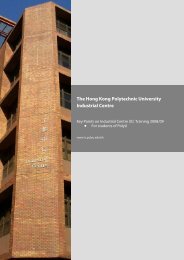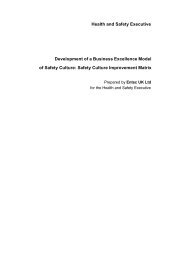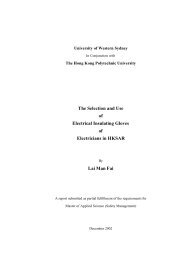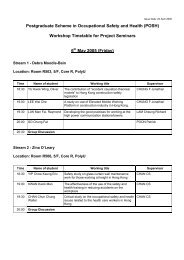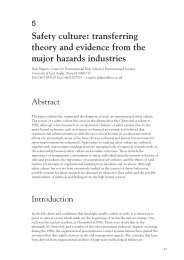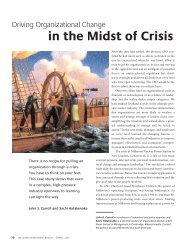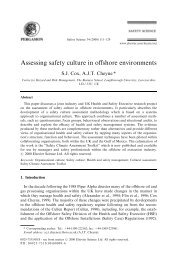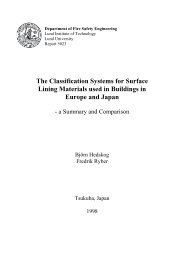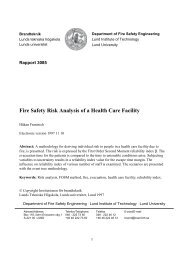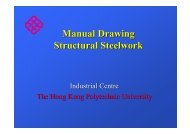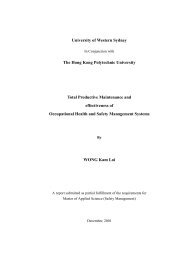An assessment of risk and safety in civil aviation - Industrial Centre
An assessment of risk and safety in civil aviation - Industrial Centre
An assessment of risk and safety in civil aviation - Industrial Centre
You also want an ePaper? Increase the reach of your titles
YUMPU automatically turns print PDFs into web optimized ePapers that Google loves.
Journal <strong>of</strong> Air Transport Management 6 (2000) 43}50<br />
<strong>An</strong> <strong>assessment</strong> <strong>of</strong> <strong>risk</strong> <strong>and</strong> <strong>safety</strong> <strong>in</strong> <strong>civil</strong> <strong>aviation</strong><br />
Milan Janic<br />
<strong>Centre</strong> for Transport Studies, Department <strong>of</strong> Civil <strong>and</strong> Build<strong>in</strong>g Eng<strong>in</strong>eer<strong>in</strong>g, Loughborough University, Loughborough, Leics LE11 3TU, UK<br />
Abstract<br />
Risk <strong>and</strong> <strong>safety</strong> have always been important considerations <strong>in</strong> <strong>civil</strong> <strong>aviation</strong>. This is particularly so under current conditions <strong>of</strong><br />
cont<strong>in</strong>uous growth <strong>in</strong> air transport dem<strong>and</strong>, frequent scarcity <strong>of</strong> airport <strong>and</strong> <strong>in</strong>frastructure capacity, <strong>and</strong> thus permanent <strong>and</strong><br />
<strong>in</strong>creased pressure on the system components. There is also the grow<strong>in</strong>g public <strong>and</strong> operators' awareness <strong>of</strong> these <strong>and</strong> other system<br />
externalities such as air pollution, noise, l<strong>and</strong> use, water/soil pollution <strong>and</strong> waste management, <strong>and</strong> congestion. This paper o!ers an<br />
<strong>assessment</strong> <strong>of</strong> <strong>risk</strong> <strong>and</strong> <strong>safety</strong> <strong>in</strong> <strong>civil</strong> <strong>aviation</strong>. It deals with general concept <strong>of</strong> <strong>risk</strong> <strong>and</strong> <strong>safety</strong>, describes the ma<strong>in</strong> causes <strong>of</strong> aircraft<br />
accidents <strong>and</strong> proposes a methodology for quantify<strong>in</strong>g <strong>risk</strong> <strong>and</strong> <strong>safety</strong>. 2000 Elsevier Science Ltd. All rights reserved.<br />
Keywords: Risk; Safety; Civil <strong>aviation</strong>; Externalities<br />
1. Introduction<br />
Society faces important challenges <strong>in</strong> how best to manage<br />
modern technology. There is a need to e$ciently <strong>and</strong><br />
safely use <strong>and</strong> manage exist<strong>in</strong>g technologies; <strong>and</strong> then<br />
how to make progress by <strong>in</strong>troduc<strong>in</strong>g new technologies.<br />
Introduc<strong>in</strong>g new technologies is usually expected to provide<br />
social bene"ts through improved e$ciency <strong>and</strong><br />
<strong>safety</strong>. There is, however a need for care <strong>and</strong> awareness <strong>of</strong><br />
the negative impacts <strong>of</strong> any technology on the environment,<br />
<strong>in</strong> its broadest sense, that can o!set at least some <strong>of</strong><br />
the ga<strong>in</strong>s from modernization <strong>and</strong> the <strong>in</strong>troduction <strong>of</strong><br />
new <strong>in</strong>novations. Optimization <strong>in</strong>volves the <strong>assessment</strong><br />
<strong>of</strong> such <strong>risk</strong> <strong>and</strong> ultimately the sett<strong>in</strong>g <strong>of</strong> st<strong>and</strong>ards to<br />
maximize society's utility from new technologies.<br />
There are di!erent de"nitions <strong>of</strong> <strong>risk</strong>. It may be de"ned<br />
as the probability <strong>of</strong> occurrence <strong>of</strong> a hazardous event <strong>in</strong><br />
given period. Second, it may be considered as the possibility<br />
that an <strong>in</strong>dividual or group be impaired through<br />
the e!ects <strong>of</strong> speci"c actions <strong>in</strong> a more or less r<strong>and</strong>om<br />
manner. Third, <strong>risk</strong> can be related to a statistically expected<br />
value <strong>of</strong> loss (i.e., the statistical likelihood <strong>of</strong><br />
a r<strong>and</strong>omly exposed <strong>in</strong>dividual be<strong>in</strong>g a!ected by some<br />
hazardous event). In this case <strong>risk</strong> <strong>in</strong>volves a measure <strong>of</strong><br />
probability <strong>of</strong> severity <strong>of</strong> adverse impacts. In addition,<br />
there are very general classi"cations <strong>of</strong> <strong>risk</strong> (Evans, 1996;<br />
Kanafani, 1984; Kuhlmann, 1981; Sage <strong>and</strong> White, 1980).<br />
E-mail address: m.janic@lboro.ac.uk (M. Janic)<br />
Risk may be voluntary or <strong>in</strong>voluntary. Voluntary <strong>risk</strong><br />
is the <strong>risk</strong> that <strong>in</strong>dividuals elect to assume which is not so<br />
with <strong>in</strong>voluntary <strong>risk</strong>. Travell<strong>in</strong>g by air represents voluntary<br />
exposure to <strong>risk</strong> <strong>of</strong> death or <strong>in</strong>jury while liv<strong>in</strong>g<br />
near a nuclear power plant or airport where some uncontrollable<br />
radiation or aircraft accident may happen,<br />
represents <strong>in</strong>voluntary exposure to <strong>risk</strong>. Risk may <strong>in</strong>volve<br />
objectively or subjectively known or assumed exposure<br />
probabilities <strong>in</strong> relation to space, population <strong>and</strong><br />
time dependency. Generally, spatial characteristic <strong>of</strong> exposure<br />
probability range from quite localized to global<br />
hazards. For many types <strong>of</strong> <strong>risk</strong>s there are groups <strong>of</strong> the<br />
population that bear speci"c <strong>risk</strong>. Dependent on whether<br />
a hazard exists over a substantial time horizon <strong>and</strong><br />
whether the e!ects or separate exposures to hazard are<br />
cumulative or not, dependent exposure probability to<br />
<strong>risk</strong> may be cont<strong>in</strong>uous, periodic <strong>and</strong> cumulative.<br />
Four types <strong>of</strong> societal <strong>risk</strong> can also be identi"ed (Sage<br />
<strong>and</strong> White, 1980):<br />
Real <strong>risk</strong> to an <strong>in</strong>dividual, which may be determ<strong>in</strong>ed<br />
on the basis <strong>of</strong> future circumstances after their full<br />
development;<br />
Statistical <strong>risk</strong>, which may be determ<strong>in</strong>ed by the available<br />
data on the <strong>in</strong>cidents <strong>and</strong> accidents <strong>in</strong> question;<br />
Predicted <strong>risk</strong>, which may be predicted analytically<br />
from the models structured from relevant historical<br />
studies; <strong>and</strong><br />
Perceived <strong>risk</strong>, which may <strong>in</strong>tuitively be felt <strong>and</strong> thus<br />
perceived by <strong>in</strong>dividuals.<br />
0969-6997/00/$- see front matter 2000 Elsevier Science Ltd. All rights reserved.<br />
PII: S 0 9 6 9 - 6 9 9 7 ( 9 9 ) 0 0 0 2 1 - 6
44 M. Janic / Journal <strong>of</strong> Air Transport Management 6 (2000) 43}50<br />
Civil <strong>aviation</strong> is an activity where all four types <strong>of</strong> <strong>risk</strong> are<br />
present. To companies provid<strong>in</strong>g <strong>in</strong>surance for airl<strong>in</strong>es<br />
#y<strong>in</strong>g constitutes a known statistical <strong>risk</strong> <strong>of</strong> the occurrence<br />
<strong>of</strong> an accident. For passengers who purchase their<br />
<strong>in</strong>surance while on the ground, #y<strong>in</strong>g represents a perceived<br />
<strong>risk</strong> that usually exceeds statistical <strong>risk</strong>. To air<br />
tra$c control authorities, anticipated changes <strong>in</strong> tra$c<br />
patterns <strong>and</strong> equipment <strong>in</strong>volve predicted <strong>risk</strong>. These<br />
changes may be su$ciently good approximations <strong>of</strong> future<br />
real <strong>risk</strong> <strong>assessment</strong>s that they are <strong>in</strong>corporated <strong>in</strong><br />
decisions on the <strong>in</strong>troduction <strong>of</strong> new ATC technology.<br />
Aircraft accidents <strong>of</strong>ten have speci"c features that can<br />
dist<strong>in</strong>guish them from accidents associated with other<br />
modes:<br />
Because #y<strong>in</strong>g may take place over long distances,<br />
accidents may occur at any po<strong>in</strong>t <strong>in</strong> time or space.<br />
Hence, there is exposure to <strong>in</strong>dividual <strong>and</strong> global<br />
hazard.<br />
Passengers <strong>and</strong> aircraft crews are primal target groups<br />
exposed to <strong>risk</strong> <strong>of</strong> an accident but there are <strong>in</strong>dividuals<br />
on the ground who may be exposed to the same<br />
accidents albeit at a lower probability.<br />
Although be<strong>in</strong>g a rare event <strong>in</strong> an absolute sense,<br />
aircraft accidents can have severe implications.<br />
Conditionally, any aircraft movement is an <strong>in</strong>herently<br />
<strong>risk</strong>y event, then, accord<strong>in</strong>g to probability theory, aircraft<br />
accidents may be classi"ed as highly unlikely<br />
(although possible) events.<br />
With respect to time dependency, <strong>risk</strong> is always present<br />
dur<strong>in</strong>g given time <strong>and</strong> space horizons (i.e., whenever<br />
a #ight takes place). The e!ect is non-cumulative<br />
<strong>and</strong> particularly related to the separate exposures <strong>of</strong><br />
the people on board.<br />
A practical problem <strong>in</strong> air transport is how to manage<br />
<strong>risk</strong> <strong>and</strong> <strong>safety</strong>. Typically, this has been resolved by<br />
<strong>in</strong>vestigations <strong>of</strong> causes <strong>of</strong> fatal accidents, <strong>assessment</strong> <strong>of</strong><br />
their <strong>risk</strong> <strong>and</strong> sett<strong>in</strong>g-up a <strong>risk</strong> st<strong>and</strong>ards consistent with<br />
society's preference function (Sage <strong>and</strong> White, 1980).<br />
Assessment <strong>of</strong> the <strong>risk</strong> <strong>of</strong> aircraft accidents may be carried<br />
out <strong>in</strong> di!erent ways, from highly <strong>in</strong>tuitive to very<br />
formal <strong>and</strong> analytical but is usually partitioned <strong>in</strong>to<br />
sub-tasks:<br />
Risk determ<strong>in</strong>ation relates to the <strong>risk</strong> identi"cation<br />
<strong>in</strong>volv<strong>in</strong>g new <strong>risk</strong> <strong>and</strong> changes <strong>in</strong> the <strong>risk</strong> parameters.<br />
The latter <strong>in</strong>volves determ<strong>in</strong><strong>in</strong>g the probability <strong>of</strong> occurrence<br />
<strong>of</strong> <strong>risk</strong>y events <strong>and</strong> the likely consequences <strong>of</strong><br />
their outcome.<br />
Risk evaluation may be decomposed <strong>in</strong>to <strong>risk</strong> aversion<br />
<strong>and</strong> <strong>risk</strong> acceptance.<br />
Risk measurement <strong>in</strong>volves quanti"cation. One convenient<br />
measure <strong>of</strong> <strong>risk</strong> is the number <strong>of</strong> accidents per<br />
unit <strong>of</strong> a system's output. Air accidents have normally<br />
be viewed <strong>in</strong> terms <strong>of</strong> fatal events with the system's<br />
output de"ned as the number <strong>of</strong> aircraft kilometers,<br />
passenger kilometers <strong>and</strong>/or aircraft departures over<br />
a given period. This is useful for compar<strong>in</strong>g <strong>risk</strong> <strong>and</strong><br />
the level <strong>of</strong> <strong>safety</strong> <strong>of</strong> di!erent transport modes, <strong>in</strong>clud<strong>in</strong>g<br />
<strong>civil</strong> <strong>aviation</strong>, as well as for monitor<strong>in</strong>g susta<strong>in</strong>ability<br />
<strong>of</strong> the sector. There are a number <strong>of</strong> ways <strong>of</strong><br />
model<strong>in</strong>g <strong>and</strong> statistically exam<strong>in</strong><strong>in</strong>g these data (<strong>An</strong>g<br />
<strong>and</strong> Tang, 1975; Johnston et al., 1989).<br />
2. The <strong>safety</strong> record<br />
In the late 1990s the world's airl<strong>in</strong>e #eet consists <strong>of</strong><br />
more than 15 000 aircraft #y<strong>in</strong>g a network <strong>of</strong> approximately<br />
15 million kms <strong>and</strong> serv<strong>in</strong>g nearly 10 000 airports.<br />
The sector directly employs more than 3.3 million people,<br />
with over 1.4 million <strong>in</strong> USA (Air Transport Action<br />
Group, 1996). Some 12 billion people <strong>and</strong> 23 million<br />
tonnes <strong>of</strong> freight are be<strong>in</strong>g moved per annum. The freight<br />
"gure represents approximately one third <strong>of</strong> value <strong>of</strong> the<br />
world's manufactured exports.<br />
Total accidents are closely related to the scale <strong>of</strong> <strong>civil</strong><br />
<strong>aviation</strong> operations. A variety <strong>of</strong> <strong>in</strong>ternational <strong>in</strong>stitutions,<br />
organisations <strong>and</strong> agencies deal with forecast<strong>in</strong>g<br />
future trends, <strong>in</strong>clud<strong>in</strong>g International Civil Aviation Organization<br />
(ICAO) <strong>and</strong> International Air Transport Association<br />
(IATA). The airspace manufacturers such as<br />
Airbus Industry, Boe<strong>in</strong>g <strong>and</strong> Rolls Royce also make<br />
projections. Some idea <strong>of</strong> projected growth can be seen <strong>in</strong><br />
Table 1 (International Civil Aviation Organization,<br />
1994). The broad range <strong>of</strong> predicted growth rates vary<br />
between 5 <strong>and</strong> 6.5% across particular forecasters with the<br />
exception <strong>of</strong> the low "gure from Fokker.<br />
Historically, when there has been relatively rapid<br />
growth <strong>in</strong> air transport, it has <strong>of</strong>ten been followed by<br />
a series <strong>of</strong> accidents. The occurrence <strong>of</strong> such events has<br />
stimulated the <strong>in</strong>troduction <strong>of</strong> technical <strong>and</strong> operational<br />
measures. As a result, overall <strong>safety</strong> has improved over<br />
time. ICAO, for example, has shown the fatality rate for<br />
<strong>in</strong>ternational <strong>and</strong> domestic schedule <strong>aviation</strong> operations<br />
has been consistently decreas<strong>in</strong>g over time. Between 1970<br />
<strong>and</strong> 1993 the fatality rate fell from 0.18 to 0.04 fatalities<br />
per 100 million passenger kilometers with particularly<br />
marked reductions recorded between 1970 <strong>and</strong> 1977.<br />
Dur<strong>in</strong>g the period 1984}1993, the trend was relatively<br />
stable. The same analysis <strong>in</strong>dicates that the number <strong>of</strong><br />
fatal accidents dur<strong>in</strong>g this 23-yr period varied between 16<br />
<strong>and</strong> 31/yr. The average number <strong>of</strong> accident per annum<br />
was 25 <strong>and</strong> the average annual number <strong>of</strong> passenger<br />
In this context, &susta<strong>in</strong>able' development can be de"ned as the<br />
development <strong>in</strong> which the system's output <strong>in</strong>creases <strong>and</strong> its negative<br />
impacts on the environment stagnate or decrease. The susta<strong>in</strong>able<br />
development <strong>of</strong> <strong>aviation</strong> sector can be evaluated through externalities<br />
such as <strong>safety</strong>, air pollution, noise <strong>and</strong> congestion (Janic, 1999).
M. Janic / Journal <strong>of</strong> Air Transport Management 6 (2000) 43}50 45<br />
Table 1<br />
Example <strong>of</strong> air tra$c forecasts<br />
Forecaster Period Average annual growth<br />
Rate (pkm) (%)<br />
Airbus Industry 1992}2001 5.8<br />
2002}2011 5.1<br />
Boe<strong>in</strong>g 1993}2013 5.2<br />
Rolls-Royce 1993}2012 5.2<br />
AcDonnell Douglas 1990}2000 6.5<br />
Fokker 1994}2013 3.5<br />
ICAO 1992}2003 5.0<br />
Source: International Civil Aviation Organisation (1994); Air Transport<br />
Action Group (1996).<br />
fatalities was 741/anuum. At the same time the output <strong>of</strong><br />
the sector rose from 1971 to 389 billion passenger-kilometers<br />
which is over a 500% <strong>in</strong>crease (International Civil<br />
Aviation Organization, 1992,1994). Some are argu<strong>in</strong>g<br />
that the scope for further improvements <strong>in</strong> <strong>safety</strong> are<br />
becom<strong>in</strong>g exhausted imply<strong>in</strong>g that if the accident rate<br />
rema<strong>in</strong>s the same, while air travel <strong>in</strong>creases, the number<br />
<strong>of</strong> accidents will <strong>in</strong>evitably rise (Cole, 1997).<br />
3. Factors caus<strong>in</strong>g fatal air accidents<br />
Investigat<strong>in</strong>g causes <strong>of</strong> fatal aircraft accidents is di$cult<br />
because they generally stem from a complex system<br />
<strong>of</strong> mutually dependent, sequential factors (Owen, 1998).<br />
These factors can be classi"ed <strong>in</strong> several ways. First,<br />
accord<strong>in</strong>g to the current state-<strong>of</strong>-knowledge they can be<br />
categorized <strong>in</strong>to known <strong>and</strong> avoidable <strong>and</strong> unknown <strong>and</strong><br />
unavoidable causes. The former should be considered<br />
conditionally <strong>in</strong> the sense that immediately after an accident<br />
the real causes are seldom fully known but as the<br />
<strong>in</strong>vestigation progresses they become known <strong>and</strong> avoidable.<br />
The causes <strong>of</strong> some accidents are never uncovered.<br />
Second, with respect to accident type, the ma<strong>in</strong> causes <strong>of</strong><br />
air accidents can conditionally be classi"ed <strong>in</strong>to human<br />
errors, mechanical failures, hazardous weather, <strong>and</strong> sabotages<br />
<strong>and</strong> military operations.<br />
Most accidents can be attributed to human error comb<strong>in</strong>ed<br />
with other factors. Human errors have been<br />
present <strong>in</strong> the production, ma<strong>in</strong>tenance <strong>and</strong> operation<br />
<strong>of</strong> <strong>aviation</strong> hardware rang<strong>in</strong>g through aircraft, airports<br />
<strong>and</strong> air tra$c control facilities <strong>and</strong> equipment. Human<br />
operational errors can come about when workloads<br />
exceed work ability, e.g., <strong>in</strong> stressful situations. In<br />
The data exclude accidents <strong>in</strong> the former USSR <strong>and</strong> the events<br />
<strong>in</strong>volv<strong>in</strong>g unlawful <strong>in</strong>terference with <strong>aviation</strong>.<br />
<strong>aviation</strong>, work<strong>in</strong>g capacity primarily depends on the<br />
ability to receive, select, process <strong>and</strong> distribute <strong>in</strong>formation<br />
on an on-l<strong>in</strong>e <strong>and</strong> o!-l<strong>in</strong>e basis <strong>in</strong> the<br />
control <strong>of</strong> <strong>in</strong>dividual aircraft or air tra$c. Long exposition<br />
to heavy mental workloads causes stress that<br />
can lead to fatigue <strong>and</strong> deterioration <strong>in</strong> work performance.<br />
Under stressful conditions, dim<strong>in</strong>ished performance<br />
may cause conscious or unconscious <strong>risk</strong>y <strong>and</strong><br />
unsafe behavior <strong>and</strong> generate errors that may result <strong>in</strong><br />
fatal accidents. The most common types <strong>of</strong> such accidents<br />
are mid-air collisions <strong>and</strong> aircraft #y<strong>in</strong>g <strong>in</strong>to<br />
terra<strong>in</strong>.<br />
Mid-air collisions have ma<strong>in</strong>ly been caused by air<br />
tra$c controller errors usually <strong>in</strong>volv<strong>in</strong>g a failure to<br />
ma<strong>in</strong>ta<strong>in</strong> prescribed separation m<strong>in</strong>ima between aircraft.<br />
For example, the mid-air collision between BEA<br />
<strong>and</strong> Inex-Adria aircraft on 10 September 1976 over<br />
Zagreb was caused by an error <strong>of</strong> air tra$c control.<br />
The <strong>in</strong>vestigation discovered that the controller had<br />
been work<strong>in</strong>g for a long period under stress caused by<br />
tra$c overload<strong>in</strong>g <strong>and</strong> weaknesses <strong>in</strong> the monitor<strong>in</strong>g<br />
equipment that left it unable to safely support exist<strong>in</strong>g<br />
volumes <strong>of</strong> tra$c. In the accident 176 people lost their<br />
lives. It <strong>in</strong>itiated improvements to the air tra$c<br />
monitor<strong>in</strong>g procedures at the location <strong>and</strong> hastened<br />
the development <strong>of</strong> airborne anti-collision equipment<br />
(Stewart, 1994).<br />
Collisions <strong>of</strong> aircraft with terra<strong>in</strong> are mostly associated<br />
with pilot-error, a cause identi"ed with many other<br />
unexpla<strong>in</strong>able air accidents. One example <strong>of</strong> air accidents<br />
caused by pilot error was the crash <strong>of</strong> a British<br />
Midl<strong>and</strong> B737 near East Midl<strong>and</strong>s Airport (UK) on<br />
8 January 1989. Forty-one passengers were killed <strong>and</strong><br />
79 survived the accident. The <strong>in</strong>quiry found that the<br />
crew made a series <strong>of</strong> mistakes caused by confusion <strong>in</strong><br />
read<strong>in</strong>g <strong>in</strong>struments <strong>in</strong> an emergency approach follow<strong>in</strong>g<br />
an eng<strong>in</strong>e failure (Owen, 1998). <strong>An</strong>other example <strong>of</strong><br />
pilot error <strong>in</strong>volved an American Airl<strong>in</strong>es B727 on<br />
8 November 1965 near C<strong>in</strong>c<strong>in</strong>nati (US). In this case,<br />
the crew made mistakes <strong>in</strong> sett<strong>in</strong>g the altimeter <strong>and</strong> <strong>in</strong><br />
determ<strong>in</strong><strong>in</strong>g the vertical position <strong>of</strong> the aircraft while<br />
approach<strong>in</strong>g the airport <strong>in</strong> ra<strong>in</strong>y weather (Stewart,<br />
1994; Owen, 1998).<br />
Crew <strong>in</strong>experience can also cause air accidents. Inexperience<br />
may lead to pilot-error, that together<br />
with other factors may cause an accident with fatal<br />
outcome. One <strong>of</strong> the examples is a crash <strong>of</strong> Air Florida<br />
B737 on 13 January 1982 just after take-o! from<br />
Wash<strong>in</strong>gton National Airport (US). Seventy "ve<br />
passengers <strong>and</strong> crew were killed <strong>and</strong> only "ve survived.<br />
The <strong>in</strong>vestigation <strong>in</strong>dicated that the ma<strong>in</strong> cause<br />
<strong>of</strong> the accident was the accumulation <strong>of</strong> ice on the<br />
aircraft w<strong>in</strong>gs <strong>and</strong> fuselage. The crew, who were <strong>in</strong>experienced<br />
<strong>in</strong> cold weather #y<strong>in</strong>g, had not operated<br />
the anti-ic<strong>in</strong>g system prior to before take-o! <strong>and</strong><br />
did not apply full eng<strong>in</strong>e take-o! power, which
46 M. Janic / Journal <strong>of</strong> Air Transport Management 6 (2000) 43}50<br />
could save the aircraft despite severe ic<strong>in</strong>g (Owen,<br />
1998).<br />
Strictly, mechanical failures result from human errors<br />
made whilst construct<strong>in</strong>g, produc<strong>in</strong>g <strong>and</strong> ma<strong>in</strong>ta<strong>in</strong><strong>in</strong>g<br />
the equipment. Such errors can accelerate metal fatigue<br />
<strong>and</strong> other failures <strong>in</strong> aircraft components. The<br />
crashes <strong>of</strong> Comets are one example (Owen, 1998) <strong>and</strong><br />
another was the problem <strong>of</strong> an Aloha Airl<strong>in</strong>es B737 <strong>in</strong><br />
1988 when the aircraft suddenly lost part <strong>of</strong> its cab<strong>in</strong><br />
ro<strong>of</strong> <strong>and</strong> sides dur<strong>in</strong>g #ight. In this latter case, <strong>in</strong>vestigators<br />
found the ma<strong>in</strong> cause <strong>of</strong> cab<strong>in</strong> crack was metal<br />
fatigue due to the frequency <strong>of</strong> take-o!s <strong>and</strong> l<strong>and</strong><strong>in</strong>gs<br />
<strong>of</strong> the aircraft <strong>and</strong> corrosion due to frequent #y<strong>in</strong>g <strong>in</strong><br />
salt air. Design problems lead to modi"cations <strong>in</strong><br />
equipment. The ma<strong>in</strong> cause <strong>of</strong> a crash <strong>of</strong> a DC-10 near<br />
Paris <strong>in</strong> 1974 that killed 346 people was weakness <strong>in</strong><br />
the aircraft's doors <strong>and</strong> di$culties <strong>in</strong> to check<strong>in</strong>g if<br />
they were closed. The result was stronger <strong>and</strong> better<br />
designed doors. The crash <strong>of</strong> a DC-10 at Chicago <strong>in</strong><br />
1979 happened due to eng<strong>in</strong>e failure. The event resulted<br />
<strong>in</strong> stricter rules <strong>and</strong> procedures cover<strong>in</strong>g eng<strong>in</strong>e<br />
ma<strong>in</strong>tenance <strong>and</strong> a review <strong>of</strong> take-o! speeds (Stewart,<br />
1974).<br />
The root-cause <strong>of</strong> many disasters orig<strong>in</strong>ates <strong>in</strong> ma<strong>in</strong>tenance<br />
workshops <strong>and</strong> <strong>in</strong> the factories where vital<br />
components <strong>and</strong> systems have been produced. <strong>An</strong><br />
example "re on a British Airtours B737 at Manchester<br />
Airport <strong>in</strong> 1985. Thermal fatigue, or weaken<strong>in</strong>g <strong>of</strong> the<br />
metal by constant heat<strong>in</strong>g <strong>and</strong> cool<strong>in</strong>g dur<strong>in</strong>g an eng<strong>in</strong>e's<br />
life produced a crack <strong>in</strong> the combustion dur<strong>in</strong>g<br />
the take-o!. The section separated from the eng<strong>in</strong>e <strong>and</strong><br />
hit the port w<strong>in</strong>g fuel tank spill<strong>in</strong>g <strong>of</strong> fuel on a hot<br />
eng<strong>in</strong>e. Subsequently, cracks were found <strong>in</strong> other eng<strong>in</strong>es<br />
<strong>of</strong> this type (Owen, 1998).<br />
Hazardous weather such as thunderstorms <strong>and</strong> frontal<br />
systems can cause troublesome w<strong>in</strong>ds, ra<strong>in</strong>, snow,<br />
fog, <strong>and</strong> low ceil<strong>in</strong>gs that may pose <strong>safety</strong> concerns<br />
at all stages <strong>of</strong> a #ight. In particular, strong w<strong>in</strong>dshear<br />
develop<strong>in</strong>g near airports can make #y<strong>in</strong>g<br />
di$cult because <strong>of</strong> its rapid change <strong>in</strong> speed <strong>and</strong> direction<br />
<strong>and</strong> because <strong>of</strong> a loss <strong>of</strong> lift <strong>in</strong> certa<strong>in</strong> conditions.<br />
The crash <strong>of</strong> an Eastern Airl<strong>in</strong>es B727 dur<strong>in</strong>g<br />
approach at New York's Kennedy Airport <strong>in</strong> June<br />
1975 o!ers a case study <strong>of</strong> the dangers <strong>in</strong>volved.<br />
Dur<strong>in</strong>g the period 1970}1987 the US National Transportation<br />
Safety Board identi"ed low-altitude w<strong>in</strong>d<br />
shear as the factor caus<strong>in</strong>g or contribut<strong>in</strong>g to 18 commercial<br />
aircraft accidents; seven were fatal result<strong>in</strong>g <strong>in</strong><br />
the loss <strong>of</strong> 575 lives. The development <strong>of</strong> sophisticated<br />
This example illustrates the importance <strong>of</strong> experience <strong>and</strong> tra<strong>in</strong><strong>in</strong>g<br />
<strong>in</strong> reduc<strong>in</strong>g the probability <strong>of</strong> an accident (Kuhlmann, 1981). However,<br />
education <strong>and</strong> tra<strong>in</strong><strong>in</strong>g <strong>of</strong> <strong>aviation</strong> sta! is expensive which poses problems<br />
at time when airl<strong>in</strong>es are under pressure to control costs (Dose,<br />
1995).<br />
weather report<strong>in</strong>g, forecast<strong>in</strong>g <strong>and</strong> detect<strong>in</strong>g systems,<br />
onboard <strong>and</strong> ground-based, have reduced this type <strong>of</strong><br />
threat.<br />
Terrorist actions are highly correlated with political<br />
<strong>and</strong> economic tensions <strong>in</strong> the world. A typical example<br />
was the crash <strong>of</strong> a B747 on 23 June 1985 due to<br />
a suspected bomb explosion. After the crash security<br />
measures at high <strong>risk</strong> airports were strengthened.<br />
Such acts have also <strong>in</strong>itiated the <strong>in</strong>troduction <strong>of</strong> new<br />
technologies <strong>and</strong> security procedures that are <strong>in</strong>tended<br />
to prevent an illegal entry onto the aircraft <strong>and</strong> to<br />
detect the presence <strong>of</strong> weapons be<strong>in</strong>g taken onboard.<br />
(Rosenberg, 1987).<br />
Military <strong>and</strong> semi-military operations have also resulted<br />
<strong>in</strong> accidents. One example was the crash <strong>of</strong><br />
a Korean B-747 over Sakhal<strong>in</strong> Inl<strong>and</strong> kill<strong>in</strong>g 269<br />
people. Due to navigational error the aircraft<br />
deviated from its prescribed course <strong>and</strong> entered<br />
Soviet airspace <strong>and</strong> #ew over a prohibited area.<br />
After several warn<strong>in</strong>gs, the aircraft was shot down by<br />
a Soviet missile. The event stimulated improved coord<strong>in</strong>ation<br />
<strong>of</strong> <strong>civil</strong> <strong>and</strong> military <strong>aviation</strong> (Stewart,<br />
1994).<br />
Human errors can be reduced by tra<strong>in</strong><strong>in</strong>g <strong>and</strong> the<br />
structur<strong>in</strong>g <strong>of</strong> air tra$c patterns so as to avoid excess<br />
stress. Factors such as hazardous weather, mechanical<br />
faults, sabotages <strong>and</strong> military operations would seem to<br />
be more r<strong>and</strong>om <strong>and</strong> less easily dealt with. This does not<br />
mean the system is unsafe. Safety should be considered<br />
with respect to the base causes <strong>of</strong> accidents. If accidents<br />
occur due to known <strong>and</strong> avoidable factors, the system<br />
should be considered as unsafe. Otherwise, if accidents<br />
occur for unknown <strong>and</strong> unavoidable reasons, the system<br />
should be considered as safe.<br />
4. A methodology for assess<strong>in</strong>g the <strong>risk</strong> <strong>and</strong> <strong>safety</strong><br />
In <strong>civil</strong> <strong>aviation</strong>, <strong>risk</strong> has been assessed as the probability<br />
<strong>of</strong> the occurrence <strong>of</strong> an air accident <strong>in</strong> terms <strong>of</strong> two<br />
aggregate <strong>in</strong>dicators, the accident rate <strong>and</strong> the fatality<br />
rate. The probability <strong>of</strong> an air accident is very low mak<strong>in</strong>g<br />
it a di$cult <strong>and</strong> complex task to properly expla<strong>in</strong>,<br />
locate, <strong>and</strong> manage overall <strong>aviation</strong> <strong>safety</strong>. There is also<br />
the need to consider the impact <strong>of</strong> policy on di!erent<br />
impacted groups such as users, service operators (airl<strong>in</strong>es,<br />
airports, air tra$c control), <strong>aviation</strong> <strong>and</strong> non-<strong>aviation</strong><br />
pr<strong>of</strong>essional <strong>and</strong> non-pr<strong>of</strong>essional organizations <strong>and</strong><br />
public (Kanafani, 1984).<br />
Two approaches for assess<strong>in</strong>g <strong>risk</strong> <strong>and</strong> <strong>safety</strong> are considerd.<br />
The causal approach looks at the number <strong>of</strong><br />
accidents <strong>and</strong> number <strong>of</strong> fatalities, the scale <strong>of</strong> the system's<br />
output dur<strong>in</strong>g a given period <strong>and</strong> other relevant<br />
characteristics that are seen as relevant causal variables.<br />
The number <strong>of</strong> accidents, deaths <strong>and</strong> <strong>in</strong>juries per unit <strong>of</strong>
M. Janic / Journal <strong>of</strong> Air Transport Management 6 (2000) 43}50 47<br />
Fig. 1. Scheme <strong>of</strong> a Poisson-type events (process).<br />
air transport output over time o!ers an <strong>in</strong>dicator <strong>of</strong><br />
whether the sector's <strong>safety</strong> is improv<strong>in</strong>g.<br />
The second approach <strong>in</strong>volves the statistical model<strong>in</strong>g<br />
the occurrence <strong>of</strong> air accidents over time; a Poisson<br />
sequence or Poisson process is <strong>of</strong>ten deployed. Such<br />
a process is based on the follow<strong>in</strong>g assumptions (<strong>An</strong>g <strong>and</strong><br />
Tang, 1975):<br />
<strong>An</strong> event can occur at r<strong>and</strong>om <strong>and</strong> at any time or any<br />
po<strong>in</strong>t <strong>in</strong> space. Past aircraft accidents have possessed<br />
this characteristic. They occurred <strong>in</strong> a r<strong>and</strong>om manner<br />
<strong>in</strong> di!erent parts <strong>of</strong> the world.<br />
The occurrence <strong>of</strong> an event <strong>in</strong> a given time or space<br />
<strong>in</strong>terval or segment is <strong>in</strong>dependent on what happened<br />
<strong>in</strong> any other non-overlapp<strong>in</strong>g <strong>in</strong>tervals or segments.<br />
Air accidents, except very rare mid-air collisions, have<br />
occurred as the series <strong>of</strong> <strong>in</strong>dependent events <strong>in</strong> time<br />
<strong>and</strong> space.<br />
The probability <strong>of</strong> an event occurr<strong>in</strong>g <strong>in</strong> a small <strong>in</strong>terval<br />
῀t is proportional to ῀t <strong>and</strong> can be estimated by<br />
λ῀t where λ is the mean rate <strong>of</strong> occurrence <strong>of</strong> the event.<br />
It is assumed constant <strong>and</strong> equal to λ"1/¹ <br />
, where<br />
¹ <br />
is the average time <strong>in</strong>terval between consecutive<br />
events. The probability <strong>of</strong> two or more occurrences <strong>in</strong><br />
῀t is negligible (<strong>of</strong> higher order <strong>of</strong> ῀t). From empirical<br />
evidence, as ῀t is assumed to be a su$ciently short<br />
period, the probability <strong>of</strong> an occurrence <strong>of</strong> more than<br />
one aircraft accident will normally be negligible.<br />
Fig. 1 illustrates a scheme <strong>of</strong> a Poisson process<br />
that commences at time t"0 <strong>and</strong> at r<strong>and</strong>om times<br />
t <br />
, t <br />
, t <br />
, 2, t <br />
, 2, t <br />
, the Poisson-type events occur.<br />
In Poisson processes the time <strong>in</strong>tervals between successive<br />
events is exponentially distributed, <strong>in</strong>dicat<strong>in</strong>g nomemory<br />
property <strong>in</strong> the process. This means that future<br />
events do not depend on the number or time <strong>of</strong> previous<br />
events. This would logically seem to be the case with air<br />
accidents. Mathematically, let ¹ be the r<strong>and</strong>om variable<br />
represent<strong>in</strong>g the time between any two consecutive<br />
events. This variable is exponentially distributed. The<br />
probability that no accident will occur <strong>in</strong> time period t is<br />
P(¹'t) K P(X <br />
"0)"e, (1)<br />
Besides national <strong>aviation</strong> authorities <strong>and</strong> airl<strong>in</strong>es, ICAO provid<strong>in</strong>g<br />
the data on <strong>safety</strong>.<br />
where, X <br />
is the number <strong>of</strong> air accidents <strong>in</strong> time t <strong>and</strong> λ is<br />
the average accident rate. Similarly, the probability <strong>of</strong> the<br />
occurrence <strong>of</strong> at least one event <strong>in</strong> time t is<br />
P(¹)t)"1!P(¹'t)"P(X <br />
O0)"1!e (2)<br />
5. Application <strong>of</strong> the methodology<br />
5.1. Causal <strong>assessment</strong><br />
Causal <strong>assessment</strong> considers <strong>risk</strong> at the global level,<br />
the level <strong>of</strong> airl<strong>in</strong>es <strong>and</strong> level <strong>of</strong> particular aircraft type. At<br />
the global level the number <strong>of</strong> deaths per passengerkilometer<br />
is taken as the dependent variable GF <br />
. This is<br />
then regressed on the number <strong>of</strong> fatalities per aircraft<br />
accident <strong>and</strong> the annual volume <strong>of</strong> passenger-kilometers<br />
denoted by N <br />
<strong>and</strong> PKM <br />
, respectively. Data for period<br />
1981}1996 are used for estimation (International Civil<br />
Aviation Organization, 1994) <strong>in</strong> the follow<strong>in</strong>g speci"cation<br />
(Janic, 1999):<br />
GF "3.80110#4.19610N <br />
(2.983) (10.674)<br />
!2.09510PKM <br />
(3.446)<br />
R <br />
"0.901; F"69.296; D="1.617; N"16. (3)<br />
The overall regression is signi"cant at the 1% level with<br />
signi"cant coe$cients (t-statistics are <strong>in</strong> parenthesis). It<br />
also has a relatively high explanatory power without "rst<br />
order auto-correlation problems (Johnston et al., 1989).<br />
The fatality rate <strong>in</strong>creases with the number <strong>of</strong> people<br />
killed per crash <strong>and</strong> decreases with the <strong>in</strong>crease <strong>in</strong> the<br />
level <strong>of</strong> output. The <strong>risk</strong> <strong>of</strong> crashes has signi"cantly fallen<br />
despite more #y<strong>in</strong>g.<br />
The <strong>safety</strong> <strong>of</strong> airl<strong>in</strong>es is assessed by regress<strong>in</strong>g the<br />
number <strong>of</strong> accidents per million #ights by an airl<strong>in</strong>e, A <br />
,<br />
on the its number <strong>of</strong> #ights, F. Fig. 2 illustrates the trend.<br />
The accident rate per airl<strong>in</strong>e has decreased more than<br />
proportionally with the cumulative number <strong>of</strong> #ights.<br />
S<strong>in</strong>ce larger airl<strong>in</strong>es have performed a larger number <strong>of</strong><br />
these #ights they would seem less <strong>risk</strong>y than smaller ones.<br />
US <strong>and</strong> European airl<strong>in</strong>es have much lower accident<br />
rates per total number <strong>of</strong> #ights than other carriers.
48 M. Janic / Journal <strong>of</strong> Air Transport Management 6 (2000) 43}50<br />
Fig. 2. Dependence <strong>of</strong> the average fatal accident rate on the number <strong>of</strong> airl<strong>in</strong>e #ights (1970}1997).<br />
Source <strong>of</strong> data: Internet (1998).<br />
The <strong>risk</strong>s associated with di!erent aircraft types<br />
are found by regress<strong>in</strong>g the number <strong>of</strong> accidents per<br />
aircraft type AR <br />
, on the number <strong>of</strong> #ights per aircraft<br />
type F <br />
, <strong>and</strong> the average age <strong>of</strong> particular<br />
aircraft type E <br />
. The data cover the period from the<br />
entry <strong>in</strong>to service <strong>of</strong> a particular aircraft type to 1992.<br />
The aircraft types covered are Fokker F28, Fokker<br />
F70/F100; Airbus A300, A310, A320; Lockheed L1011;<br />
British Aerospace BAe146; Boe<strong>in</strong>g B727, B737-1/200,<br />
B737-3/4/500, B747, B757, B767; McDonnell Douglas<br />
DC9, MD80 (Internet, 1998; Walder, 1991). The equation<br />
used is<br />
AR "1.206 #1.743F #0.900E <br />
(0.692) (6.355) (3.887),<br />
R"0.929; F"84.640; D="1.823; N"16. (4)<br />
The overall equation <strong>and</strong> <strong>in</strong>dividual coe$cients are signi"cant<br />
at the 1% level. The equation may o!er an<br />
explanation <strong>of</strong> the past but this <strong>in</strong>formation was not<br />
available <strong>in</strong> advance to those <strong>in</strong>volved. The equation<br />
<strong>in</strong>dicates that the cause <strong>of</strong> air accidents could stem<br />
from the existence <strong>of</strong> geriatric factors that escalated<br />
faster as aircraft are utilized more <strong>and</strong> age. Because<br />
the operational hypothesis is that aircraft accidents happen<br />
as r<strong>and</strong>om events, the equation does not imply that<br />
more used <strong>and</strong> older aircraft have been less safe. It<br />
<strong>in</strong>dicates that the <strong>risk</strong> <strong>of</strong> travel<strong>in</strong>g <strong>in</strong> these aircraft is<br />
higher.<br />
5.2. Probabilistic <strong>assessment</strong><br />
The probabilistic <strong>assessment</strong> <strong>of</strong> accidents uses<br />
a sample <strong>of</strong> 259 accidents over the period 1965}1998. The<br />
distribution <strong>of</strong> time <strong>in</strong>tervals between these events is<br />
shown <strong>in</strong> Fig. 3. A simple calculation provides an estimate<br />
<strong>of</strong> the average accident rate: λ7.818 accidents per<br />
year or λ0.020 accidents per day. <strong>An</strong> analysis <strong>of</strong> the<br />
time <strong>in</strong>tervals between accidents, <strong>in</strong>dependent <strong>of</strong> aircraft<br />
type, <strong>in</strong>dicates they have been <strong>in</strong>dependent <strong>and</strong> exponentially<br />
distributed (a χ test con"rms the hypothesis<br />
match<strong>in</strong>g the empirical <strong>and</strong> theoretical data, <strong>An</strong>g <strong>and</strong><br />
Tang, 1975). This o!ers con"rmation that the observed<br />
pattern <strong>of</strong> accidents can be treated as Poisson process.<br />
Us<strong>in</strong>g the exponential distribution seen <strong>in</strong> Fig. 3, it is<br />
possible to assess the probability <strong>of</strong> an occurrence <strong>of</strong> an<br />
air accident. If there is unlikely to be any improvement <strong>in</strong><br />
<strong>safety</strong> features then this distribution can be used for<br />
assess<strong>in</strong>g the probability <strong>of</strong> future events. Fig. 4 illustrates<br />
the probability <strong>of</strong> the occurrence <strong>of</strong> at least one air<br />
accident per period t. This probability rises over time<br />
until the event. For example, the probability <strong>of</strong> at least<br />
one accident by the follow<strong>in</strong>g day from now is about 0.02,<br />
by next month 0.45, by six months 0.97, <strong>and</strong> by next year<br />
0.999.<br />
5.3. Assessment <strong>of</strong> deaths <strong>and</strong> <strong>in</strong>juries<br />
To complete the analysis <strong>of</strong> past accidents, the distributions<br />
<strong>of</strong> air accidents, fatalities <strong>and</strong> survivors per aircraft<br />
category can be separated. Aircraft can be treated as<br />
turbojets, turbo-props <strong>and</strong> piston-eng<strong>in</strong>e; see Table 2.<br />
The largest number <strong>of</strong> accidents <strong>in</strong>volved turbo-prop<br />
aircraft but the greatest number <strong>of</strong> people <strong>in</strong>volved <strong>in</strong><br />
The accidents <strong>in</strong>volved aircraft types, Boe<strong>in</strong>g B727, B737, B747,<br />
B757, B767, B777 (no event); MD80, DC10, MD11; Lockheed L1011,<br />
Airbus A300, A310, A320, A330 (no events), A340 (no events); Fokker<br />
F28, F100; British Aerospace BAe 146; Embraer EMB-110 B<strong>and</strong>eirante,<br />
EMB-120 Brasilia; Dorrnier 228; <strong>and</strong> Saab 340.
M. Janic / Journal <strong>of</strong> Air Transport Management 6 (2000) 43}50 49<br />
Fig. 3. Distribution <strong>of</strong> time <strong>in</strong>tervals between consecutive air accidents (1965}1998).<br />
Source <strong>of</strong> data: Internet (1998).<br />
accident (although some survivors have been severely<br />
<strong>in</strong>jured).<br />
6. Conclusions<br />
Fig. 4. Dependence <strong>of</strong> the probability <strong>of</strong> the occurrence <strong>of</strong> at least one<br />
air accident with<strong>in</strong> time period t (accord<strong>in</strong>g to the distribuion shown <strong>in</strong><br />
Fig. 3).<br />
accident were on turbojet aircraft because the latter can<br />
carry more passengers.<br />
Regard<strong>in</strong>g the number <strong>of</strong> deaths per accident<br />
(1965}1998), there were 130 events <strong>in</strong>volv<strong>in</strong>g no survivors<br />
imply<strong>in</strong>g an overall probability <strong>of</strong> death dur<strong>in</strong>g an air<br />
accident <strong>of</strong> about 50%. In the absolute numbers, the<br />
analysis shows that the average number <strong>of</strong> deaths per<br />
accident has been N <br />
"76 (σ <br />
"81) <strong>and</strong> the total number<br />
<strong>of</strong> people onboard on the aircraft when the accident<br />
happened is N <br />
"103 (σ <br />
"88). By further elaborat<strong>in</strong>g<br />
the above "gures, it can be seen that about 73% <strong>of</strong><br />
passengers <strong>and</strong> crews have been killed dur<strong>in</strong>g the aircraft<br />
This paper has presented a methodology for <strong>assessment</strong><br />
<strong>risk</strong> <strong>and</strong> <strong>safety</strong> <strong>in</strong> <strong>civil</strong> <strong>aviation</strong>. The outcomes<br />
con"rm that the accident <strong>and</strong> fatality rates have decreased<br />
<strong>in</strong> l<strong>in</strong>e with <strong>in</strong>creases <strong>in</strong> the volume <strong>of</strong> the sector's<br />
output. The accident rate has been more frequent at more<br />
heavily used <strong>and</strong> older aircraft which supports ideas <strong>of</strong><br />
permanent monitor<strong>in</strong>g, detect<strong>in</strong>g <strong>and</strong> remedy<strong>in</strong>g such<br />
th<strong>in</strong>gs as metal fatigues.<br />
Air accidents belong to a class <strong>of</strong> extremely rare events<br />
<strong>in</strong> the context <strong>of</strong> the volume <strong>and</strong> <strong>in</strong>tensity <strong>of</strong> the operations<br />
<strong>and</strong> activities <strong>in</strong>volved. Some <strong>of</strong> the most recent<br />
evidences <strong>in</strong>dicates that despite positive past trends, it<br />
seems that it will be di$cult to cont<strong>in</strong>ue to reduce <strong>risk</strong>s.<br />
The implications <strong>of</strong> this is an absolute <strong>in</strong>crease <strong>in</strong> the<br />
number <strong>of</strong> fatalities <strong>and</strong> accidents. ICAO's long-tra$c<br />
forecasts <strong>in</strong>dicate that if the rate <strong>of</strong> accidents stays stable<br />
until 2003, the number <strong>of</strong> fatalities will <strong>in</strong>crease by about<br />
75% with the number <strong>of</strong> fatal accidents ris<strong>in</strong>g to 40/yr,<br />
respectively (Corrie, 1994). This poses a range <strong>of</strong> problems<br />
for policy makers. High numbers <strong>of</strong> accidents will<br />
<strong>in</strong>evitably attract considerable media attention but <strong>aviation</strong><br />
is the safest mode <strong>of</strong> transport. Transferr<strong>in</strong>g resources<br />
to cont<strong>in</strong>ually reduce the average <strong>risk</strong> <strong>of</strong> an<br />
accident or fatality from other, much more dangerous<br />
modes <strong>of</strong> transport or from other sectors, such as health
50 M. Janic / Journal <strong>of</strong> Air Transport Management 6 (2000) 43}50<br />
Table 2<br />
Characteristics <strong>of</strong> fatal accidents by aircraft category<br />
Aircraft category<br />
Fatal accidents per<br />
type <strong>of</strong> aircraft (%)<br />
Killed people<br />
per aircraft (%)<br />
Survived people<br />
per aircraft (%)<br />
Number <strong>of</strong> people<br />
died per aircraft<br />
Number <strong>of</strong> survived<br />
people per aircraft<br />
Turbojet 34.2 69.6 86.5 56 41<br />
Turbo-prop 48.5 28.1 11.4 16 4<br />
Piston-eng<strong>in</strong>e 17.3 3.3 2.1 5 2<br />
Source: International Civil Aviation Organization (1992); Internet (1998).<br />
care or support <strong>of</strong> the elderly, will <strong>in</strong>evitably cause even<br />
more deaths <strong>in</strong> society as a whole.<br />
References<br />
<strong>An</strong>g, H-S.A., Tang, H.W., 1975. In: Probability Concepts <strong>in</strong> Eng<strong>in</strong>eer<strong>in</strong>g<br />
Plann<strong>in</strong>g <strong>and</strong> Design: Vol. I } Basic Pr<strong>in</strong>ciples. Wiley, New<br />
York.<br />
Air Transport Action Group, 1996. The Economic Bene"ts <strong>of</strong> Air<br />
Transport. ATAG, Geneva.<br />
Cole, J., 1997. Overview <strong>of</strong> <strong>aviation</strong> <strong>safety</strong> issues, Paper presented at<br />
The Seventh <strong>An</strong>nual Aviation Forecast Conference. NATCA-National<br />
Air Tra$c Controllers Association, Wash<strong>in</strong>gton.<br />
Corrie, S.J., 1994. Potential growth <strong>in</strong> air travel dem<strong>and</strong>s renewed e!ort<br />
to improve <strong>safety</strong> record. International Civil Aviation Organisation,<br />
Montreal, Canada, ICAO Journal 7}9.<br />
Dose, A., 1995. Safety is best served by pay<strong>in</strong>g close attention to the key<br />
elements <strong>in</strong> its management. ICAO Journal 20}21.<br />
Evans, A.W., 1996. Risk <strong>assessment</strong> by transport organisations. Transport<br />
Reviews 17, 145}163.<br />
International Civil Aviation Organisation, 1992. Investment requirements<br />
for aircraft #eets <strong>and</strong> for airport <strong>and</strong> route facility <strong>in</strong>frastructure<br />
to the year 2010. Circular 236, ICAO, Montreal.<br />
International Civil Aviation Organisation, 1994. ICAO projects longterm<br />
moderate tra$c growth <strong>of</strong> 5 per cent per year. ICAO Journal<br />
20}21.<br />
Internet, 1998. Safety <strong>in</strong>formation for airl<strong>in</strong>e passengers. http://airsafe.com/airl<strong>in</strong>e.htm.<br />
Janic, M., 1999. Aviation <strong>and</strong> externalities: the accomplishments <strong>and</strong><br />
problems. Transportation Research D 4, 159}180.<br />
Johnston, A.C., Johnston, M.B., Buse, R.C., 1989. Econometrics: Basic<br />
<strong>and</strong> Applied. McMillan, New York.<br />
Kanafani, A., 1984. The analysis <strong>of</strong> hazards <strong>and</strong> the hazards <strong>of</strong> analysis:<br />
re#ections on air tra$c <strong>safety</strong> management. Institute <strong>of</strong> Transportation<br />
Studies, University <strong>of</strong> California, Berkeley, Work<strong>in</strong>g paper,<br />
UCB-ITS-WP-84-1.<br />
Kuhlmann, A., 1981. Introduction to Safety Science. Spr<strong>in</strong>ger, New York.<br />
Owen, D., 1998. Air Accident Investigation: How Science Is Mak<strong>in</strong>g<br />
Fly<strong>in</strong>g Safer. Patrick Stephens Limited, Yeovil.<br />
Rosenberg, B., 1987. Air <strong>safety</strong>: the state <strong>of</strong> art. Aviation Week <strong>and</strong><br />
Space Technology 51}66.<br />
Sage, A.P., White, E.B., 1980. Methodologies for <strong>risk</strong> <strong>and</strong> hazard<br />
<strong>assessment</strong>: a survey <strong>and</strong> status report. IEEE Transaction on System,<br />
Man, <strong>and</strong> Cybernetics SMC-10, 425}441.<br />
Stewart, S., 1994. Air disasters: dialogue from the black box. The<br />
Promotional Repr<strong>in</strong>t Company Limited, Leicester.<br />
Walder, R., 1991. Age<strong>in</strong>g aircraft programme entails major e!ort <strong>and</strong><br />
expense. ICAO Journal 6}8.



